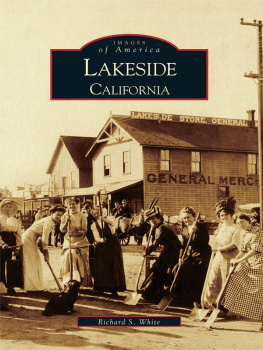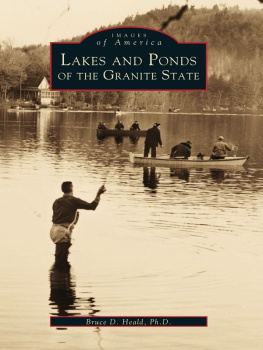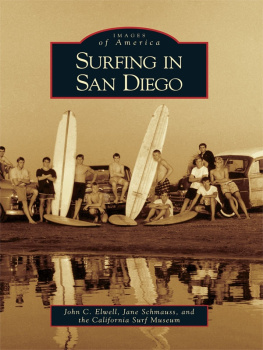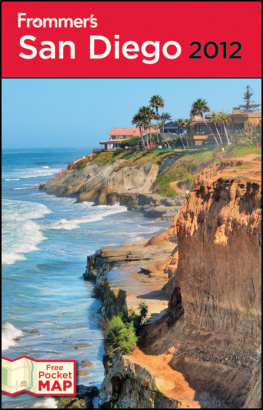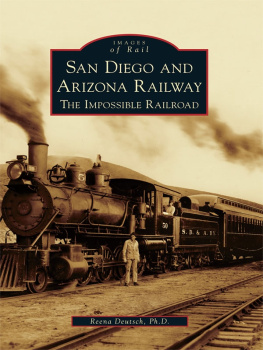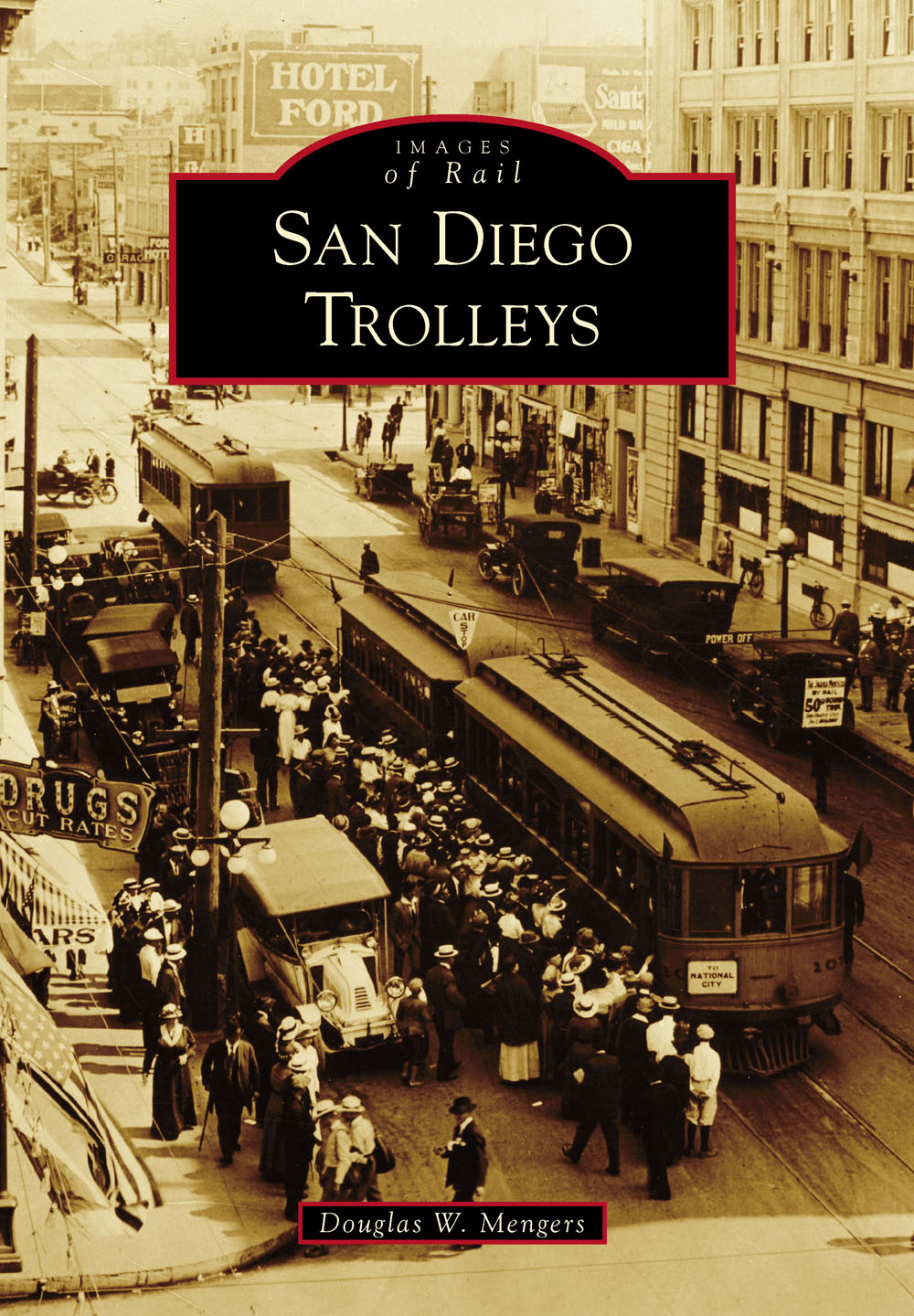
IMAGES
of Rail
SAN DIEGO
TROLLEYS

The San Diego Electric Railway (SDERy) was founded in 1891 by John D. Spreckels. The map here shows the SDERy at its maximum extent in 1925, stretching from La Jolla to the Mexican border. Also represented are bus (motor coach), ferry, and steam railroad lines owned or operated by Spreckels. (Courtesy of Richard V. Dodge.)
ON THE COVER: Passengers board San Diego & Southeastern Railroad (SD&SE) car No. 101 and trailer around 1915. Looking north on Third Avenue from Broadway, the U.S. Grant Hotel and Superba Theatre can be seen on the right. An offshoot of the National City & Otay Railroad, the SD&SE was an electric interurban line serving San Diego and National City. (Courtesy of the Pacific Southwest Railway Museum.)
IMAGES
of Rail
SAN DIEGO
TROLLEYS
Douglas W. Mengers

Copyright 2017 by Douglas W. Mengers
ISBN 978-1-4671-2664-9
Ebook ISBN 9781439662342
Published by Arcadia Publishing
Charleston, South Carolina
Library of Congress Control Number: 2017946459
For all general information, please contact Arcadia Publishing:
Telephone 843-853-2070
Fax 843-853-0044
E-mail
For customer service and orders:
Toll-Free 1-888-313-2665
Visit us on the Internet at www.arcadiapublishing.com
For Anna and our dreams.
ACKNOWLEDGMENTS
This project is the result of many people working in the background to provide advice, direction, and resources. Dennis Gallegos provided the initial spark and has been an invaluable professional mentor. Mike Reading and Richard Finch generously provided access to the San Diego Electric Railway Association photograph archives and frequently directed me to valuable material I was unaware of. Bruce Semelsberger of the Pacific Southwest Railway Museum shared his extensive knowledge of the Southwest Railway Library collections and spent many hours locating and scanning photographs. Christine Travers, Carol Myers, and Natalie Fiocre of the San Diego History Center were a pleasure to work with as we dove deep into their photographic archives, ironing out kinks along the way. Likewise, Stephanie Washburn of the Coronado Historical Association was a great help in tracking down specific photographs taken in Coronado.
Michael Taylor and NWB Environmental Services LLC, a San Diegobased cultural resource management firm specializing in a comprehensive array of archaeological services, provided financial resources, without which this project would not have been possible. My employer, Alice Brewster, and PanGIS Inc., a consulting firm that specializes in archaeological, GIS, and environmental compliance, provided the financial support and scheduling flexibility to complete this project. Finally, Anna Graham Shonle of Graham Edits provided developmental editing and proofreading services for this project, the quality of which are known primarily to myself.
Thank you to all the above persons and organizations for helping to take this project from the idea stage to the final product. All your time and efforts are greatly appreciated.
Unless otherwise noted, the images in this volume appear courtesy of Aaron R. Duggan, PyroCat Photo/Graphic (AD); Alberto Foglia, MA, RPA (AF); the Coronado Historical Association (CHA); the author (DM); the Orange Empire Railway Museum (OERM); the Pacific Southwest Railway Museum (PSRM); the San Diego Electric Railway Association (SDERA); and the San Diego History Center (SDHC).
INTRODUCTION
San Diegos historical trolleys are receiving renewed interest lately with the centennial of the 19151916 Panama-California World Exposition. The expo marked the introduction of over 100 modern (for their time) Arts and Craftsstyle trolley cars to a greatly expanding public transportation system. Over the last decade, historical streetcars from this era have been restored by museums and citizen groups, and plans are being discussed to reestablish the old trolley line serving Balboa Park museums and the San Diego Zoo. The expo period is only a small part of the story of San Diegos historical trolleys. The first horse-drawn streetcars of the 1880s, including those of the San Diego Streetcar Company, connected the commercial core of Alonzo Hortons new downtown to nearby wharves and resort hotels. A similar system operated on Coronado, connected to San Diego by a ferry across the bay.
A series of boom and bust cycles occurred in San Diego between the 1870s and 1890s. Some were magnified by local issues, such as rumors of a transcontinental railroad connection; others were the result of broader national economic forces. Regardless of the cause, they played out in San Diego as massive influxes and outflows of population, and the rise and collapse of businesses of every size, including those related to transportation. City development came in spurts with the booms and came to a halt with the busts. The arrival of electrification in the 1880s coincided with a growth in municipal services, including street lighting and water and sewer services.
Experiments with electrically powered streetcars soon began using this newly harnessed energy source to replace animal power for public transportation. While short-lived, the Electric Rapid Transit venture was an encouraging example of the wide-ranging uses of new technology being used to address urban problems. In the late 1890s, the San Diego Cable Railroad, a cable-driven streetcar system, like that successfully operated in San Francisco, was built. It too failed after a short timea victim of the boom and bust cycle.
John D. Spreckels, a wealthy industrialist from San Francisco, began investing in San Diego infrastructure in the late 1880s. He oversaw construction of a commercial coaling wharf and bought into existing struggling ventures such as the Hotel Del Coronado, the San Diego and Coronado Ferry, and the Otay Water Company. In 1891, Spreckels formed the San Diego Electric Railway Company (SDERy). He began buying and consolidating several of San Diegos failed or failing transportation lines and began a process of massive expansion. By 1910, Spreckelss SDERy would be the only remaining trolley operator in San Diego. The stability provided by a large, centralized trolley network ushered in a new age of public transportation in San Diego. Spreckelss maxim that transportation determines the flow of population was perfectly timed to take advantage of a massive increase in population in San Diego and the greater Southern California region. This population movement, known as the Midwestern Migration, saw San Diegos population increase tenfold by the mid-1920s and politically, economically, and culturally transformed California from the periphery to the core.
The new SDERy routes extended into barren scrubland and paved the way for new neighborhoods that are in revival today, such as North Park, or are the core of historic districts, such as Mission Hills. New power plants, other facilities, and modern trolley cars were introduced over the next decade as planning for the 19151916 expo ramped up. The trolley lines served to bring commuters to the downtown area for work and shopping. They also provided transportation to new destinations built by the trolley companies and other developers, including picnic grounds, public baths, and amusement parks.
After the exposition, however, the system began to decline; the costs of materials increased during World War I, and funding was diverted by Spreckels to a railroad connection to the east. Even so, a major upgrade and repair project took place in the 1920s, along with the introduction of many modern cars. Once a new rapid line to the beach communities to the north was opened mid-decade, SDERy achieved its maximum extent.
Next page


